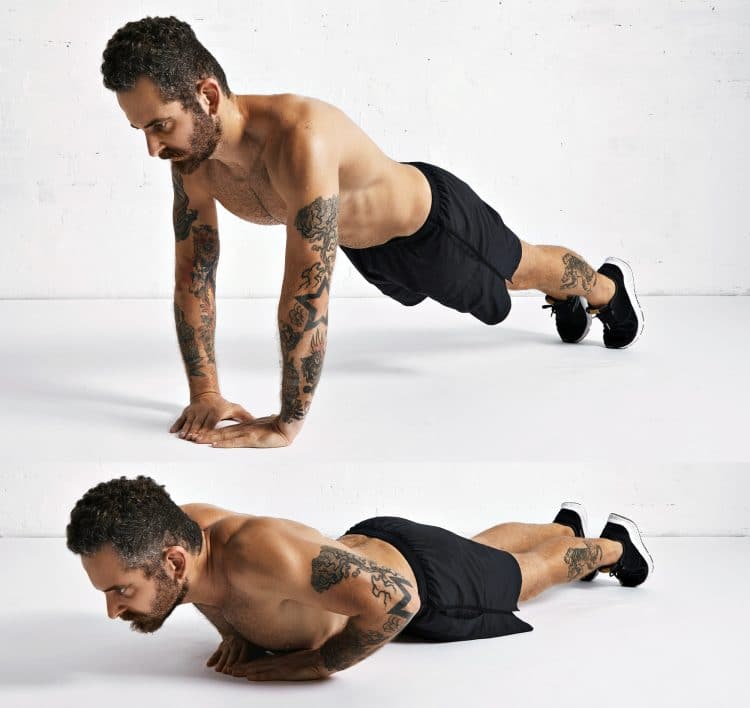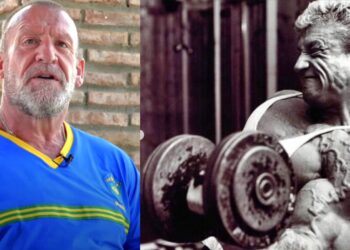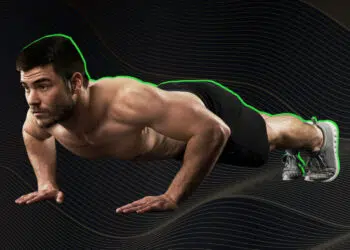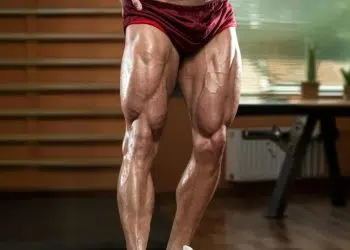If you want to build bigger, stronger triceps, the close (or narrow) grip bench press is hard to beat (1). Unlike many triceps isolation exercises, this popular movement allows you to lift heavy weights, which is why it’s a staple of powerlifting and powerbuilding training.
The narrower grip is also very shoulder-friendly, which is why a lot of lifters gravitate toward it when regular bench presses start to bother their joints.
However, like any exercise, even the mighty close grip bench press will start to lose its potency if you do it too long or too often. Like eating the same meal every day, doing the same exercises over and over can become boring and make your workouts less productive.
The good news is that you don’t have to limit yourself to doing nothing but close grip bench presses for your triceps, and there several similarly effective exercises you can do instead.
In this article, we reveal the nine best close grip bench press alternatives that’ll keep those triceps gains coming for years to come!
Close Grip Bench Press Anatomy
The close grip bench press is a compound exercise. That means it involves two or more joints and several muscles working together in synergy. Compound exercises are generally more functional than isolation exercises, better for building strength, and more time-efficient, too.
Level Up Your Fitness: Join our 💪 strong community in Fitness Volt Newsletter. Get daily inspiration, expert-backed workouts, nutrition tips, the latest in strength sports, and the support you need to reach your goals. Subscribe for free!
Needless to say, to be considered a viable alternative to the close grip bench press, any exercise must work the same muscles, so it’s worth mentioning what muscles are trained by close grip bench presses:
Triceps brachii
Triceps brachii means three-headed arm muscle. Known simply as the triceps for short, this muscle makes up around 60% of your upper arm mass. The functions of the triceps are elbow extension and shoulder extension. Because of the loads involved, close grip bench presses are an excellent exercise for building and strengthening the triceps.
Deltoids
The deltoids, or delts for short, are your main shoulder muscles. There are three sets of fibers, called heads, in the deltoids: anterior (front), medial (side), and posterior (rear). While all three heads are active during close grip bench presses, the anterior head does most of the work and the other two act mostly as stabilizers.
Pectoralis major
Like regular bench presses, the close grip bench press provides your chest with a decent workout. However, the pecs are somewhat less active in the close grip variation. So, if you want to emphasize your pecs, you should do bench presses with a regular grip or choose an alternative exercise.
9 Close Grip Bench Press Alternatives for Bigger, Stronger Triceps
Add some variety to your triceps workouts with these nine proven alternatives to the close grip bench press.
1. Close grip Smith machine press
A lot of trainers have a genuine dislike for the Smith machine, stating that it’s non-functional. But what if hypertrophy is your goal? In that case, the Smith machine can be very functional indeed.
The bar is guided on rods, and you can set the weight catchers, so the bar won’t come crashing down on your chest if you cannot complete a rep. This means you are free to train to failure in complete safety while putting all your energy into driving the bar up and not trying to balance it.
With all that in mind, it’s clear that the close grip Smith machine bench press is an excellent alternative to doing this exercise with freeweights.
How to do it:
- Adjust the Smith machine barbell to waist height. Set the weight safety catchers so the bar will stop just above your chest.
- Place a bench under the bar. Lie down on your back, so your lower chest is directly under the barbell.
- Grab the barbell with an overhand closer than shoulder-width grip and unrack the bar.
- Extend your arms straight. This will be your starting position.
- Slowly lower the bar until it touches the weight catchers. Keep your upper arms tucked into your sides.
- Drive the bar back up to the starting position and repeat.
- Repeat for recommended reps.
Pro tip: Use a false or thumbless grip (aka the suicide grip), so you can rotate your hands outward slightly to pull your elbows closer to your sides. This will maximize triceps engagement and increase shoulder stability.
2. Neutral grip Smith machine bench press
While this exercise is definitely unusual, it’s a very effective way to train your triceps, deltoids, and inner chest. Like all Smith machine exercises, it’s an excellent choice for building muscle in relative safety, even if it’s not as “functional” as most freeweight and bodyweight pushing exercises.
How to do it:
- Place a bench horizontally under the Smith machine bar. Lie on the bench so the bar runs vertically up your body. Push a neutral grip handle up under the bar and hold it with both hands.
- Unrack the weight (you may need a training partner to do this for you), and then extend and bend your arms as usual. Keep your upper arms tucked into your sides.
- Rerack the weight, rest, and repeat.
Pro tip: This exercise works best with medium reps and a moderate weight, e.g., 8-12 reps with around 65-75% of your 1RM. This is not such a good exercise for very heavy weights. Instead, chase the pump and do your best to maximize your mind-muscle connection.
3. Close grip floor press
No bench? No problem! You can do close grip presses while lying on the floor, i.e., a close grip floor press. This exercise is even more shoulder-friendly than the close grip bench press and forces you to lower the weight under control for bigger strength gains.
How to do it:
- Set up a squat rack, so the J-hooks are set to about knee height. Place a barbell on the hooks.
- Lie down on the floor, so your eyes are directly beneath the bar.
- Grip the bar with an overhand, slightly narrower than shoulder-width grip. Pull your shoulders back and down and press your upper back into the floor. This will increase shoulder stability.
- Unrack the bar and hold the weight with your arms straight. Inhale, bend your arms, and lower the bar until the back of your upper arms lightly touch the floor.
- Without bouncing, forcefully extend your arms and push the weight back up to arms’ length. Continue until you have completed all the required reps. Then, on completion, carefully re-rack the bar.
Pro tip: Experiment by doing this exercise with your legs bent or straight to see which you prefer. Bent legs, feet flat on the floor, is a little more lower back-friendly, more stable, and may allow you to lift more weight.
4. Triceps dips
Before bench presses became popular in the 1950s, the dip was the most widely performed chest and triceps exercise in most gyms. Dips might only be a bodyweight exercise, but they’re still a fantastic strength and mass builder.
There are a couple of ways to do dips, so make sure you perform this variation to maximize triceps activation.
How to do it:
- Use dipping bars that are no wider than shoulder-width apart. A wider grip will take stress off your triceps.
- Place your hands on the bars with your palms turned inward. Support your weight on straight arms.
- Let your legs hang down below you and keep your torso as upright as possible. Some forward lean is unavoidable and expected but try to keep it to a minimum.
- Bend your arms and descend until your elbows are bent to around 90 degrees or more. Tuck your arms in and imagine you are pointing your elbows behind you.
- Push yourself upward, extending your arms fully but not quite locking your elbows. Pause here for 1-2 seconds to really challenge your triceps.
- Descend and repeat.
Pro tip: Make triceps dips even better for building strength by wearing a dipping belt or weighted vest loaded with 10-50% of your body weight. Lower (1 to 5) reps with heavy weights are the best way to build strength.
5. Close grip dumbbell press
You don’t need a barbell to do close grip bench presses. This dumbbell variation is just as effective and provides your chest with a more challenging workout. Also, with dumbbells, you can just lower the weights to the side if you hit muscular failure and cannot do any more reps.
How to do it:
Level Up Your Fitness: Join our 💪 strong community in Fitness Volt Newsletter. Get daily inspiration, expert-backed workouts, nutrition tips, the latest in strength sports, and the support you need to reach your goals. Subscribe for free!
- Sit on an exercise bench with a dumbbell in each hand. Using a neutral grip, place and press the dumbbells together. Pull your shoulders down and back, and brace your abs.
- Lie flat on the bench and hold the dumbbells on your chest. Press the weights inward as hard as you can. Tuck your upper arms into your sides.
- Push the weights up and over your chest until your arms are straight but not locked. Keep the tension on your pecs by continuing to press the weights together.
- Lower the dumbbells to your chest and repeat.
Pro tip: Do not ease up on the inward pressure; keep pushing the dumbbells together for the entire duration of your set. Try doing this exercise on a slight decline to increase triceps engagement.
6. Diamond push-ups
According to the American Council on Exercise, the diamond or triangle push-up is one of the best triceps exercises around (2). It’s an excellent choice for home lifters as you do this exercise without additional equipment. However, it can be a little hard on your wrists, elbows, and shoulders, so don’t do too much of this exercise too soon.

How to do it:
- Kneel down and place your hands flat on the floor so your thumbs and first fingers form a triangle.
- With your arms extended, move your feet out and back until your body is straight. Brace your core, tuck your chin in, and lengthen your neck. Pull your shoulders down and back.
- Keeping your body straight, bend your arms and lower your chest down to the back of your hands. Keep your elbows close to your sides.
- Push back up and repeat.
Pro tip: Bend your legs and rest on your knees to make this exercise easier. To make it harder, raise your feet and place them on a chair or exercise bench, or wear a weighted vest.
7. Neutral close grip dumbbell push-ups
If diamond push-ups bother your wrists, this variation could be the solution. Placing your hands on parallel dumbbells means you can keep your wrists straight, eliminating most of the joint stress. Hex dumbbells are best because they’re less likely to roll.
How to do it:
- Place your dumbbells on the floor, so they’re close together and parallel.
- With your arms extended, grip the dumbbells and move your feet out and back until your body is straight. Brace your core, tuck your chin in, and lengthen your neck.
- Keeping your body straight, bend your arms and lower your chest toward the floor. Descend as far as you can. Keep your elbows close to your sides.
- Push back up and repeat.
Pro tip: You can also do this exercise using raised push-up handles or with a push-up board.
8. JM press
The JM press is named after powerlifter JM Blakely, one of the best bench pressers in history. In fact, this was the only triceps exercise he used to bench 300kg (660lbs) at a bodyweight of 140kg (308lbs) to win the WPC world champs back in 1998.
This exercise is part skull crusher and part close grip bench press. If you want triceps that are bodybuilder big and powerlifter strong, this is the exercise you should use!
How to do it:
- Set up as usual for close grip bench presses, i.e., hands a little less than shoulder-width apart, bar held over your chest. Brace your abs, plant your feet firmly on the floor, and pull your shoulders down and back.
- Bend your arms and push your elbows forward, so the bar comes down toward your chin.
- Press the weight back up and repeat.
Pro tip: Use a false or thumbless grip (aka the suicide grip), so you can rotate your hands toward your little fingers and pull your elbows closer to your sides to maximize triceps engagement and shoulder stability.
9. Tate dumbbell press
The Tate press was invented by legendary powerlifting coach Dave Tate. One of the founders of Westside Barbell, arguably the most successful powerlifting gym in the world, the Tate press is an unusual exercise that’s part chest press and part triceps extension. WSB powerlifters do this exercise to beef up their triceps for a bigger bench press.
How to do it:
- Lie on a bench with a dumbbell in each hand. Press the weights up and over your chest, thumbs pointing inward.
- Bend your arms and lower the dumbbells inward and down to your chest. Push your elbows outward and point your little finger up toward the ceiling.
- Press the weights back up to the starting position and repeat.
Pro tip: You can do this exercise on a flat or incline bench and also lying on the floor. Don’t go too heavy too soon with this exercise; it’s much harder than it looks!
FAQs
1. What rep range should I use for my triceps workouts?
Your rep range depends on your goal and what equipment you have available. For example, if you are training for strength, you should mainly use heavy weights and low reps, i.e., 1-5 reps per set with 85% or more of your 1RM.
If you are training for hypertrophy or muscle growth, higher reps and lighter weights work best, e.g., anywhere from 6-30 reps per set (3).
Of course, if you only have access to light weights or are doing bodyweight exercises, you’ll just have to train to failure regardless of how many reps you do. Taking your sets close to failure will increase muscle size and improve your strength, although strength gains will be somewhat less than when lifting heavy weights.
2. Are compound or isolation exercises better for building bigger triceps?
While isolation exercises allow you to target your triceps more precisely, compound exercises let you lift more weight. Both approaches can help trigger hypertrophy, so it makes sense to use compound and isolation exercises to maximize muscle growth.
That said, if you are short of time, focusing on compound exercises is a more efficient way to train as you can work your triceps alongside your other upper body pushing muscles.
3. Some of these exercises hurt my elbows. Is this normal?
Elbow joint and tendon pain suggest that you are either doing something wrong, overdoing it by using too much weight, or have an underlying joint problem or injury. You may also benefit from stretching your triceps.
But, regardless of the cause, you should NOT ignore pain, as what starts as an annoying ache can soon become a chronic injury.
So, dial down the weight, tighten up your form, and see if the pain dissipates. If the exercise still hurts your elbows, ditch that movement and try something else. Not all exercises are suitable for all lifters. If pain persists, get it checked out by a medical professional in case you have an injury that needs corrective treatment.
More Alternative Exercises:
- Best Decline Bench Press Alternatives and Substitutes
- Best Bench Press Alternatives For A Big, Powerful Chest
- The Best Pec Deck Alternatives for an Awesome Chest
Wrapping Up
The close grip barbell bench press is a very satisfying exercise to do. It’ll help you build bigger, stronger triceps and, best of all, will increase your regular barbell bench press performance.
But, it’s not the only compound exercise you can do for your triceps, and doing it for too long or too often could make it less effective.
So, shake up your triceps workouts with these nine close-grip bench press alternatives. Each one is just as effective but is also different enough to help you avoid training plateaus and progress ruts.
References:
1- Research Gate: The Close-Grip Bench Press https://www.researchgate.net/publication/318289674_The_Close-Grip_Bench_Press
2- American Council on Exercise (ACE): ACE Study Identifies the Best Triceps Exercises https://www.acefitness.org
3- PubMed: Effects of resistance training performed to repetition failure or non-failure on muscular strength and hypertrophy: A systematic review and meta-analysis https://pubmed.ncbi.nlm.nih.gov/33497853/

Interested in measuring your progress? Check out our strength standards for Bench Press, Push Ups, Floor Press, and more.









